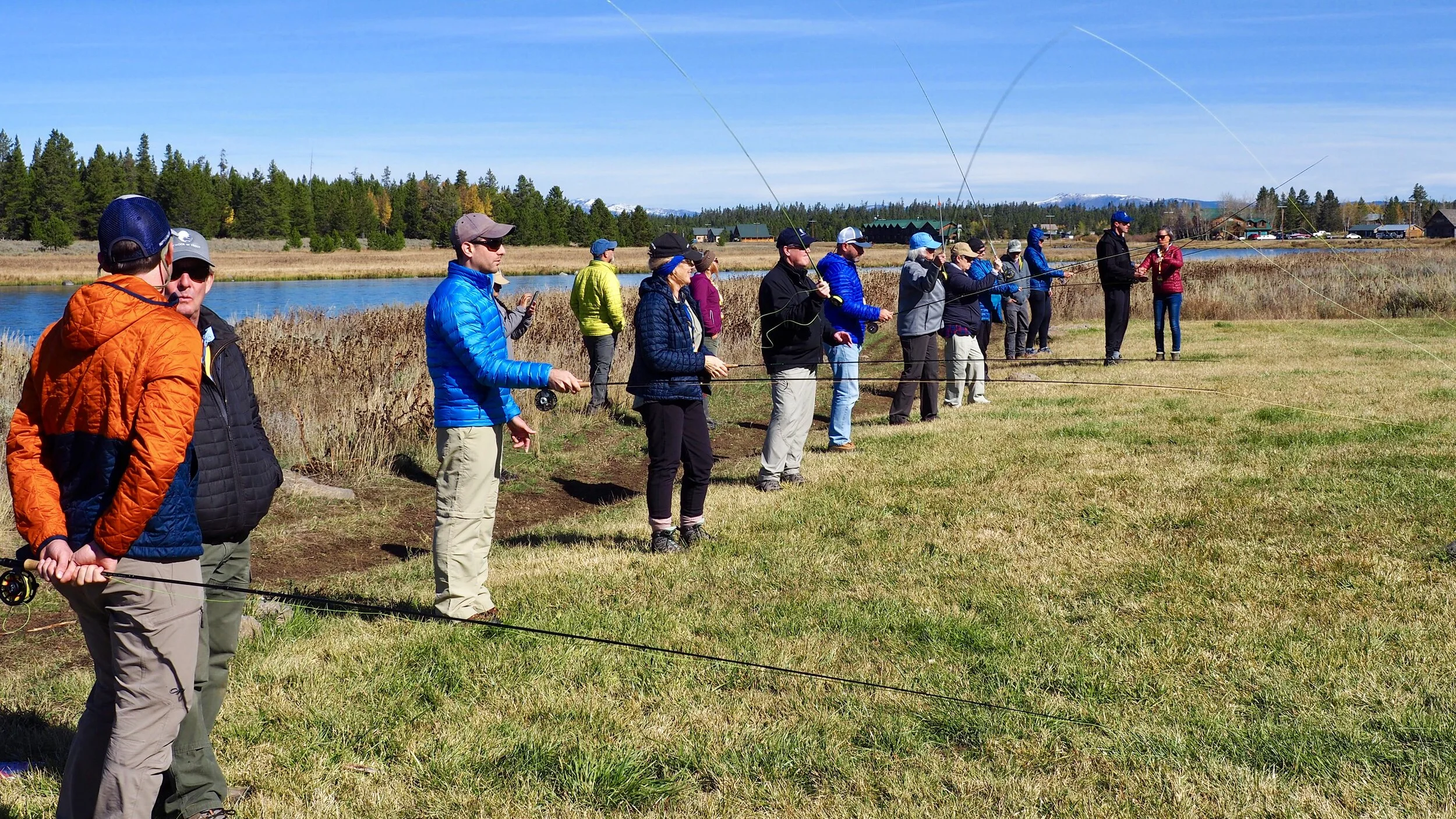Tips for School of Trout Graduates
Here are 50 different fly fishing tips for School of trout graduates
Practice your casting. (Somewhere in Montana, John Juracek just smiled.)
Raise your elbow on your backcast, _______. (Insert your name here.)
Practice your casting … but don’t try to practice while you’re fishing. Practice at home, or at the local park, or on a local pond, or wherever you find enough room without power lines or other dangers. Make sure you refer to John’s casting rules if you have any questions. (Feel free to drop me a note if you need a copy of his casting tips.)
Don’t get hung up on equipment. While good gear makes your fishing easier and more pleasurable - and while leaky waders are no fun at all - a proficient angler can fish with almost any rod or reel.
Remember what Mac said: “Safety, fun and learning, in that order.”
Work on your knots. Knots and casting are two places where muscle memory is truly important.
We spent time talking about line handling and line control at the class. Along with knots and casting, your line handling should become subconscious and automatic. The basic rule (with very few exceptions) is that the line is always under control. Which means the line is either between your thumb and your fore-finger on your rod hand, or in your grasp in your non-rod hand. And when you strip line in, always strip from below your rod hand.
Remember Hilary’s epic talk about adventures, and do what you can to keep that spirit of adventure alive in your fly fishing.
Play all your fish as quickly as possible, and make sure to keep them wet.
A good rule of thumb when it comes to playing a fish is that you should never be in a stalemate. Either the fish is taking the line out or you’re bringing the line in. Someone is always winning the fight.
When it comes to fly lines, the higher the number, the heavier the line.
Conversely, the higher the X size, the lighter the leader or tippet.
You learned a bunch of knots. Figure out which ones are your favorites and concentrate on perfecting those.
A bobbin or a nail knot tool makes tying nail knots much, much easier.
Always wade safely, and be aware of potential dangers (deep water, sweepers, slippery rocks, fast currents, floating ice or debris, weeds, etc.) that could prove problematic.
In deep or fast flows, keep your body sideways to the current. Also, don’t wade deeper than your waist.
Use a wading belt, and make sure it fits snuggly.
When you’re casting, make sure your pivot point is at your shoulder and that you keep lifting and lowering your elbow. (Somewhere, John just smiled again.)
The length of your casting stroke is determined by the length of your cast.
Several instructors demonstrated how to get a good drift. Depending on the situation, some of the key points are 1) introducing slack in your leader when you cast, or 2) mending your line before your fly starts to drag, or 3) when you’re casting downstream, be sure to keep your line & leader upstream of your fly.
When you dead drift your dry fly, it should float like it’s not attached to the line. At all. You don’t want drag or micro-drag.
When you dead drift your nymphs and you’re using a strike indicator, your indicator should go just a little slower than the speed of the surface current. Why? Because the surface water is always a little quicker than the water down low in the water column. If your indicator - oops, your bobber - is moving the same speed as the water’s surface, your nymphs will drag down below.
The reach cast. Learn it. Remember it. Perfect it. Use it.
Lengthen your casting stroke, and open up your loop, when you’re casting weighted nymphs or streamers.
If you’re downstream of the fish, set the hook as soon as you see the take.
If you’re upstream of the fish, wait for a micro-second before you set the hook.
You can fish pretty much any trout stream effectively with a 9’, 5 wt. rod, an appropriately sized reel, and a 5 wt. weight forward floating line.
Weight forward lines will give you a little more casting distance, while double taper lines will load better in close for shorter casts.
Fishing is supposed to be fun. Never lose sight of that.
If you get angry, frustrated, or stressed out on the water, take a break and get yourself back in the right frame of mind. That way you’re far less likely to fish poorly.
Learn to tie flies. You don’t have to tie them all, but tie at least some of your flies.
You had a chance to meet some truly exceptional fly fishers on the Henry’s Fork. Even better, they’re all great people. And now that you know them, and they know you, don’t be afraid to drop them a note with your questions or comments. I can’t promise that they’ll respond immediately … but why wouldn’t you reach out and say “Hi!” if the spirit moves you?
If you’re looking for incredible sporting art, make sure you get in touch with our friend Bob White. Bob wasn’t able to join us at the October class because of a last second issue, but he is absolutely wonderful and his artwork is stunning.
There’s really no “wrong” way to fish a streamer.
When you wade, especially in slow water, always move slowly, without pushing a wake.
While it’s important to read about fly fishing, and to watch videos, there is absolutely no substitute for time on the water.
Focus on developing your awareness. Pay attention to what’s happening around you on the river. The best way to do that is to sit your butt down on the bank when you first arrive. Then take the time to watch the water until you’ve mellowed out and slipped into a more relaxed, more observant frame of mind.
Think “Wizard of Oz” when it comes to terrestrials. But instead of “lions and tigers and bears,” substitute “beetles and hoppers and ants, oh my.”
Mayflies look like little sailboats on the water. Caddis fly erratically and have tent-shaped wings. The wings on a stonefly lay flat on its back.
You don’t need to know the Latin names of bugs. Sure, it’s cool. But you don’t need to know all those scientific names.
Focus on catching one fish first. Just one. And then, once you’re successful, you can focus on the next one. But take it one fish at a time.
When you mend your line on the water, try not to move your fly or your strike indicator.
Always anticipate your mends, and mend just before the indicator or the fly starts to drag.
The lower the number, the bigger the hook. (A size 10 is bigger than a size 16.)
Get in the habit of always pinching the barbs on your hooks. Always. Pinch. Your. Barbs.
Because of an oversight on my part, we did not teach you how to remove a fly embedded in your flesh. With that in mind, don’t hook yourself. (But if you do, please consult a medical expert or follow generally accepted medical practices.)
Always respect both the fish and the resource, and treat other anglers the way you’d like to be treated.
Tim showed you how to take excellent photos. When you take those excellent photos, be sure to send a few to the School of Trout so we can share them on our social media posts.
Pass along what you learned. Don’t hoard it. Pay it forward.
I typically carry a water bottle, a granola bar, chocolate and kleenex/toilet paper in my sling pack. I also try to have a towel, dry clothes, extra food and drinks, a first aid kit, and maybe a couple of Advil in my vehicle. It’s definitely better to have everything you might need before you arrive at the water.
Here’s hoping that at least a few of these tips will come in handy. And if you have any questions, please don’t hesitate to drop me a note or give me a call. - Todd
For anyone who’s interested … we currently have just one “advanced” class scheduled for 2020, and as of January 20th, six of the ten available slots are filled. (Several by 2019 students.) If you think you might want to join us on the Henry’s Fork when the temperatures are far, far warmer than what we experienced last October — there’s no way we’re going to have snow in August, right? — then please consider sending in your application sooner rather than later.
I’d also like to share a few of the stories I’ve published, on the chance that the information contained within will prove helpful to some of you.


